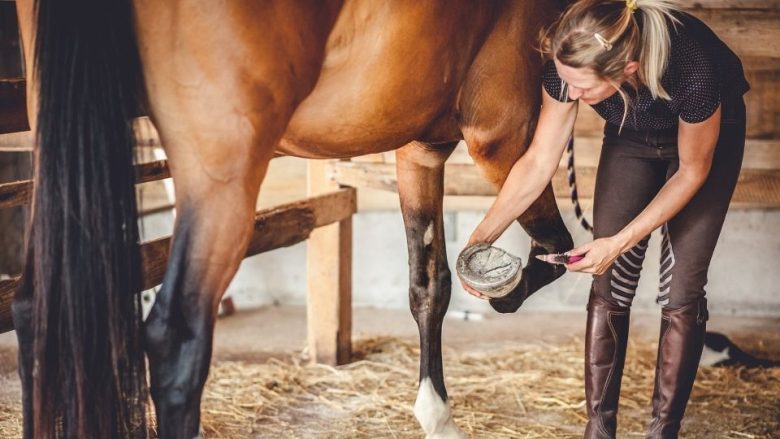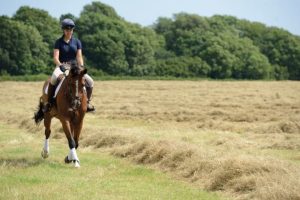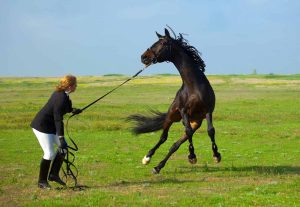Caring for your horse’s hooves is crucial as part of your overall horse health management strategy. There is an old proverb that says, “No hooves, no horse,” which illustrates how important it is to maintain the condition of your horse’s feet to ensure an overall improvement in his health and performance. Good foot care not only prevents hoof problems, but also improves your horse’s performance in various sports and activities. The purpose of this article is to provide horse owners and caregivers with seven basic guidelines to help them manage their horses’ hooves more effectively.
1. Regular Cleaning and Inspection:
Regular inspections and cleaning are the most important parts of good head care. Clean hooves every day to remove dirt, rocks, and feces, which can cause problems such as thrush (a bacterial hoof disease). This regular inspection gives you the chance to catch any problems, such as cracks, chips, or signs of infection early so they can be repaired immediately.
2. Make Sure You Eat a Balanced Diet:
Nutrition is very important for the health of your feet. Maintain strong feet with a balanced diet rich in important nutrients like biotin, Omega-3 fatty acids, methionine, zinc, and copper. Adding products specifically made for hoof health may be helpful, especially for horses that already have hoof problems. But before making any changes to your horse’s diet, you should consult your veterinarian or equine nutritionist.
3. Trim and Wear Shoes:
To maintain the correct shape and balance of the hoof, it needs to be trimmed regularly and, if necessary, dressed. Hoofs should be clipped approximately every 6 to 8 weeks, depending on the horse’s growth rate and where he lives. When a horse’s hooves are not cared for properly, structural imbalances can occur. This changes the horse’s posture and gait, which can be painful and lead to more serious health problems.
4. Ensure Moisture Balance:
Moisture has a huge impact on hoof health. Too much water can make your feet soft, making them more susceptible to injury or illness, while too little water can make your feet dry and brittle. Keeping your horse’s environment dry by making sure he is not exposed to moisture for extended periods, and using hoof conditioners or dressings can help maintain a proper moisture balance.
5. Ensure Adequate Exercise and Turnout:
For good head growth and blood circulation, it is important to exercise regularly and participate in exercises. Moving around helps blood flow to your legs, which is important for your feet to get nutrients and help them grow. Giving your horse plenty of room to move around and making sure they get regular exercise can help prevent many hoof issues.
6. Solve the Problem Immediately:
Any signs of hoof problems, such as lameness, feeling warm in the hoof, seeing strange growth patterns, or visible wounds, should be addressed immediately. Catching and treating problems early is important to prevent minor problems from becoming worse. If your horse’s hoof is injured, you should consult a veterinarian or a trained farrier.
7. Learn more About the Topic and Talk to Experts:
Finally, it’s helpful to understand the anatomy of hooves, common diseases, and how to care for them. Attend seminars, read reliable sources, and talk to experts like farriers and veterinarians. These professionals can provide you with personalized assistance and treatment options to ensure your horse receives the best possible care.
Conclusion:
Regular maintenance, a good diet, and timely professional help are all important components of good hoof care. By using these seven tips when caring for your horse, you can help your horse stay healthy and strong. As the saying goes, “There is no horse without hooves.” Remember, taking good care of your horse’s hooves is an investment in his overall health and performance.
FAQs:
1. How often should I trim my horse’s hooves?
Horses’ hooves should be trimmed approximately every six to eight weeks, but this can change depending on how active the horse is, how quickly the hooves grow, and the weather. Talk to a trained farrier to find out what time is best for your horse.
2. What are the signs of healthy feet?
Healthy hooves have firm, smooth skin without cracks or flakes. The V-shaped part, the frog’s hoof, should be hard and flexible, not soft or rotten. There should be no unpleasant odor, which could mean you have an infection such as thrush.
3. Will your hooves be healthier if you change your diet?
A healthy, balanced diet is important for joint health. Supplements with biotin, omega-3 fatty acids, methionine, zinc, and copper can help keep feet healthy and strong. Discuss with an equine nutritionist how you can tailor the diet to your horse’s needs.
4. How do you prevent hoof injuries in horses?
Regular trimming, eating a balanced diet, keeping the horse’s hooves clean and dry, giving the horse the right amount of activity, and treating any signs of hoof problems immediately are preventive measures. Regular visits to your veterinarian and doctor can also help prevent problems.
5. What should I do if my horse has a cracked hoof?
If your horse’s hooves begin to crack, see a farrier or veterinarian immediately. Treatment will depend on the severity and location of the crack but may include pruning, trimming, or other measures to prevent more damage and help the bone heal.
6. Do all horses have to wear shoes?
Not every horse needs shoes. Whether a horse needs shoes depends on how active he is, the terrain he is in, and the health of his hooves. Some horses simply require regular trimming and can perform well without shoes, while other horses require shoes for safety, immobilization or to enhance their performance.
7. How can I maintain the correct humidity in the horse’s hooves?
Managing your living space and using non-hygroscopic bedding are two ways to maintain proper humidity. Hoof conditioners or bandages can help prevent hooves from breaking during dry weather. Talk to your farrier about meeting your horse’s unique needs.



